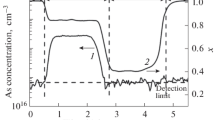Abstract
Arsenic is known to be an amphoteric impurity that may occupy either sublattice in HgCdTe depending upon sample annealing. As an acceptor in low concentrations, it offers several features that are attractive for the fabrication of certain n + -on-p detector diode structures. The epitaxial growth of arsenic-doped HgCdTe from a Te-rich melt can fulfill the requirements for application in a variety of devices where low vacancy concentrations and low defect densities are critical requirements in minimizing dark currents. These devices may include the high operating temperature (HOT) detectors operated in a strong nonequilibrium and reverse bias mode to suppress the Auger-generated dark currents. For the materials’ growth process to be effective, the segregation coefficient determining the incorporation of arsenic from the Te-rich melt needs to be established. This coefficient was measured during these investigations and was observed to vary with arsenic concentration. Within the range of interest, this parameter varied between 8×10−6 and 1×10−4. These extremely small values limit the doping that can be achieved to <5×1016 cm−3 in the grown epifilm. Furthermore, the large addition of arsenic to the melt, necessitated by the extremely small segregation coefficients, leads to a condition where the concentration of arsenic in the liquid-phase epitaxy (LPE) nutrient melt exceeds that of cadmium. The melt chemistry, phase diagram, and epigrowth process fundamentally change as a result. This new epigrowth process was developed and tuned during these investigations. For acceptor levels at 1×1015 cm−3 and lower, the growth of arsenic-doped HgCdTe from a Te-rich LPE melt has been determined to be an extremely reproducible, powerful, and controllable technique.
Similar content being viewed by others
References
D. Chandra, M.W. Goodwin, M.C. Chen, and J.A. Dodge, J. Electron. Mater. 22, 1033 (1993).
D. Chandra, M.W. Goodwin, M.C. Chen, and L.K. Magel, J. Electron. Mater. 24, 599 (2005).
Y. Nemirovsky and R. Fastow, Properties of Mercury Cadmium Telluride, EMIS Datareview Series No. 10, ed. P. Capper (INSPEC, U.K.: IEE, 2004), p. 233.
T. Tung, J. Cryst. Growth 86, 161 (1988).
P. Capper, B.C. Easton, P.A.C. Whiffin, C.D. Maxey, and I. Kenworthy, Mater. Lett. 6, 365 (1988).
C.J. Summers, R.G. Benz, B.K. Wagner, J.D. Benson, and D. Rajavel, Proc. SPIE 1106, 2 (1989).
D. Chandra, J.H. Tregilgas, and M.W. Goodwin, J. Vac. Sci. Technol. B9, 1852 (1991).
H.F. Schaake, J. Appl. Phys. 88, 1765 (2000).
D. Chandra, H.F. Schaake, M.A. Kinch, F. Aqariden, C.F. Wan, D.F. Weirauch, and H.D. Shih, J. Electron. Mater. 31, 715 (2002).
C.T. Elliott, Properties of Mercury Cadmium Telluride, EMIS Datareview Series No. 10, ed. P. Capper (INSPEC, U.K.: IEE, 2004), p. 339.




